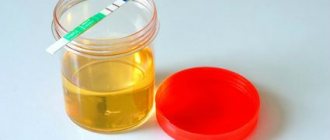Ways to collect urine from a baby boy?
> Care >
Taking a urine test is necessary to monitor the child’s health; it allows you to identify possible diseases and inflammatory processes in the baby.
A referral for laboratory testing is usually given at the age of 3 months - if there have been no problems with the baby’s health before.
And here young parents fall into a stupor, because for an adult, collecting urine for analysis is not difficult, but what about a child who does not control his urination and is almost constantly either in his arms or in a horizontal position? In addition, the laboratory has a limited time for receiving tests, and if you do not have time to “seize the moment” in time, then waiting for the next one, you may not have time to submit the material. That is why preparation for the first urine test in children should be very thorough.
What preparations are required for urine collection?
For the reliability of the analysis, absolute cleanliness is required - the child’s genitals must be cleanly washed and wiped, and the container in which the material will be collected must be sterile. You can boil a small jar the old fashioned way, or buy inexpensive sterile containers at the pharmacy.
Morning urine is suitable for general analysis, as it is more concentrated.
Also, in order to avoid protein fractions from contaminated urinary tracts getting into the material, it is recommended to collect “average” urine.
It is correct to wait a little until the baby begins to write, and only then catch the stream for analysis.
But the bladder of infants is still small, its volume is 35-50 ml, and for diagnosis, 25 ml of material is required - it is clear that wasting the “precious” liquid and collecting only average urine will be inappropriate.
How to collect urine from a baby boy correctly?
Some parents are at a loss when faced with the task of collecting urine from a baby. After all, it is unknown when the baby will want to go to the toilet, there is a risk of missing this moment, and the time range between urination in newborn children is about two hours. In addition, the issue of the child’s position while waiting can also cause difficulty.
Some mothers carry the baby in their arms, placing the container against the genitals, while others lay the baby down and patiently wait for the process to begin, distracting the child. In these cases, the parents of boys, due to the open access to the external genital organs, are certainly in a better position than the parents of girls.
Let's look at recommendations on how to collect urine from a baby:
- You can place the washed baby on a diaper with polyethylene, adjusting the edges so that the liquid does not drain, but accumulates, and just wait. The advantage of this method is that the baby is absolutely not constrained by anything, he can move freely and will not behave capriciously. This method is suitable for every child - both boys and girls. After the act of urination occurs, you simply pour the liquid into the container. But collecting urine for analysis requires complete sterility, and dust and dirt may be present on the surface of the polyethylene, which will make the result unreliable. Then you will have to take the test again.
- Another way to collect urine from a baby is to directly apply a sterile jar to the genitals of a boy or girl. Since constant contact with the container can cause discomfort for the child, it is usually inserted immediately after the start of urination. In this case, there is a risk of being a little late and collecting an insufficient amount of material for the laboratory.
- A very practical and convenient way to collect urine from children is to use special urinals. They are freely sold in pharmacies and are cheap. There are two forms of urinals: universal (suitable for both boys and girls) and for male children, with a special recess for the testicles.
A urine bag is a sterile plastic bag with a hole around which hypoallergenic glue is applied. After removing the protective film, you should tape the urine collection container around your genitals. All you have to do is wait for the moment to urinate and make sure that the bag does not come off. If you doubt that you can use this device correctly, refer to the instructions.
https://www.youtube.com/watch?v=UE3WR9YkxFE
In order for the urine bag to be securely attached, the child’s skin must be thoroughly dried after washing.
When a child pees, you can estimate the volume of fluid received thanks to the scale that, as a rule, is applied by all manufacturers of urinals. Then you need to pour the urine into a sterile container and take it to the clinic for analysis.
How to help a baby pee?
If you have prepared everything for collecting the analysis, but the child does not want to go to the toilet, you can stimulate his desire to urinate:
- The sound of pouring liquid can speed up the approach of this act - turn on the water in the bathroom or pour it from glass to glass;
- Most often, the process of urination occurs when the baby eats - feed him or give him water to drink
- You can also gently stroke the tummy in the area of the bladder above the pubis.
It is unacceptable to force a child to freeze or put him on wet sheets to stimulate urination - in this case, you will only harm the health of your baby, and cause inflammation of the internal genital organs in the girl.
Ways to collect urine from a baby boy? Link to main publication
Source: https://NewBabe.ru/uhod/kak-sobrat-mochu-u-grudnichka-malchika.html
Collecting urine using a urine bag
So, before starting to collect urine from a baby, every mother should remember some rules, namely:
- The urine must certainly be the first in the morning, the one that the kidneys processed overnight.
- Before collecting the material, you should wash the child’s genitals well, since all the bacteria on the skin will inevitably get into the tests during urination and show a bad result.
- The container for collecting and administering tests must be sterile.
- The best and most reliable result is obtained by medium urine, but in the case of infants it is difficult to catch the medium stream.
- After urine collection, it is transported to the laboratory in the next 2-3 hours, in a closed sterile flask labeled with the child’s name.
The simplest and most effective way to collect urine from infants today is to use a special urinal, which can be purchased at almost any pharmacy. The urine bag is a thick plastic bag with a scale printed on it, which is attached with Velcro between the child’s legs, in the area around the genitals, so that when urinating, all the liquid ends up in the middle of the sterile bag. Since there are some anatomical differences between children of different sexes, there are urinals on sale with holes of different widths, as well as universal ones that are suitable for both girls and boys.
Reading...
What to do if your baby starts coughing?
Before attaching the urine bag, the child must be thoroughly washed with warm water and fragrance-free soap; you can additionally wipe it with a sterile damp cloth. The skin around the genitals must be completely dry for the Velcro to attach and stay secure. After the bag has been secured, it is advisable not to swaddle the child, sit him down or put a diaper on top. It is best to hold the baby in your arms in a columnar position, while controlling the position of the legs and the reliability of the urinal fixation. To further stimulate the process, you can give the child a drink of clean water from a bottle, and also run water in the tap; its gurgling will cause the urge to urinate.
Additionally > Causes of tummy pain in a baby and what to do about them
After the long-awaited action has taken place and the urine is in a transparent bag between the legs, carefully remove the urinal. Now the task is to pour its contents into a sterile plastic container, marked with today's date and surname. To begin with, compare the amount of urine and the volume of the plastic container; if there is no more urine than prescribed, you can simply cut off the corner of the urinal, holding it over the container and pour the urine in this way. If there is a little more of the collected material, it is poured in the same way, but the first stream is released past the flask.
How to collect urine from a newborn girl and boy for analysis
A urine test for newborn babies is a quick and effective way to find out about the child’s health. Correct collection of biomaterial helps to obtain accurate and reliable results.
Why should a newborn have a urine test?
A general urine test should be taken for children who have had streptococcal diseases in order to monitor the state of their kidneys, and after any previous illnesses in order to monitor the recovery process.
In what other cases does a newborn need to undergo a general urine test:
- as a routine examination per month, when the baby turns six months and one year old;
- if there is a suspicion of pathology of the kidneys or other organs;
- before admission to the hospital;
- before vaccinations to eliminate contraindications to the procedure.
Rules for preparing for the test
In order for the test results to be reliable and not have to be repeated, urine must be collected correctly. To do this, there are certain rules for collecting urine from newborns that must be followed:
- Urine is collected in the morning; only fresh morning urine is tested.
- You cannot donate urine collected in the evening or at night, even if it is stored in the refrigerator.
- Before collecting urine, the newborn must be washed with baby soap, and the genitals are thoroughly treated so that impurities from them do not get into the urine and distort the analysis.
- You cannot donate urine if the child was previously given medications.
- Urine is collected in a sterile container so that it is clean and free of foreign impurities.
- You cannot donate urine by squeezing it out of a diaper or diaper.
How to collect urine for analysis from a newborn
There are several ways to collect urine for analysis from your baby. Each of them has its own advantages and disadvantages. The choice of a specific option depends on what is more accessible and convenient for the baby’s parents.
You can collect urine for analysis using:
- test jars;
- plastic bag;
- urinal;
- glass container.
How to collect urine from a newborn using a urine bag
The factory urinal has virtually no disadvantages. The disadvantages include:
- you need to buy it in advance at the pharmacy (it’s better to buy two at once to practice);
- it takes skill to put it on the baby;
- the baby can be capricious, children do not like it when something is stuck on their delicate skin.
Advantages of collecting urine using a urine bag:
- If you follow the instructions, urine collection is quite simple;
- it is sterile;
- all urine is collected in a urine container for newborns and does not spill around;
- there is a volume gradation on the collection bag;
- easy to find for sale in pharmacies.
- Carefully tear the package and straighten the contents.
- Remove the adhesive tape and carefully attach as shown in the picture.
- For convenience, there is a yellow cross on the urinal, which should be located between the genitals and the anus.
- It is better to hold the baby in your arms before he pees. This way the urine will definitely not spill.
- Distract your child with conversations and songs so that he does not pay attention to the unpleasant sensations from the attached urinal.
- When the baby has peed, the urine bag is carefully removed.
- Open the urine collection jar, cut the tip of the urine bag above it and drain the urine into the test jar.
- The jar must be tightly closed with a lid, and the urine bag must be thrown away.
Collecting urine from a newborn without a urine bag
If for some reason you cannot use a urine bag, there are other ways to collect urine from a newborn without a urine bag:
- use the regular new package;
- collect urine directly into a container for analysis;
- collect urine in a glass plate.
How to collect urine using a bag
To collect urine in this way, you need to take a clean new bag (sterility is paramount). What to do next:
- Cut the bag on the sides to create ties.
- Build something like a diaper for the baby by tying the ends of the bag on the hips, and leaving the bag itself hanging between the legs, under the genitals.
- Hold the baby in your arms so that urine does not spill.
- As soon as the baby pees, remove the bag and pour the urine into a jar for collecting tests.
- sterile;
- Just;
- This is a cheap analogue of a urinal.
Disadvantages: it is inconvenient to build such a device without skill.
It should be noted that this should not be a garbage bag, only a food bag is suitable so that it does not contain any impurities.
How to collect urine from a newborn girl
First of all, the baby needs to be washed thoroughly. Options for collecting material for research:
- Using a urine bag. To do this, the girl is placed on her back and a urinal is attached to her genitals. When the baby pees, carefully remove the bag and pour the urine into a container for analysis.
- Using a glass plate.
This is a good method that our mothers used to use. A wide flat plate is washed clean and doused with boiling water. The cooled plate is placed under the girl’s butt.When the baby pees, the girl’s legs are carefully lifted, a plate is taken out and the urine is poured into a container.
Collecting boy's urine
The boy is also thoroughly washed before the analysis is collected. Ways to collect urine from a newborn boy:
- Using a urine bag. Calm your baby before attaching the urine bag. Attach the device and wait for the boy to pee. When your child urinates, carefully remove the urine bag and drain the urine into a container.
- Using a collection jar (sterile container for collecting urine).
The boy is washed and laid on oilcloth, on top of which a disposable or regular diaper is placed. Wait until you urinate. Place the jar under the genitals so that the urine flows into the jar. This method is convenient because you don’t have to collect the first portion of urine (the first second of urination), when urine washes away bacteria from the external genitalia.The test result will be reliable.
Interpretation of a general urine test in newborns
Usually on laboratory test forms there is a column with the norms of indicators for a certain age.
What should the urine values of a healthy newborn be:
- The color of urine in healthy newborns is light yellow, pale yellow, without turbidity or flakes. It should be transparent.
- The pH level shows the reaction of urine in newborns: it should be neutral or slightly alkaline in infants, after introducing complementary foods it gradually changes to slightly acidic.
- Urine specific gravity (SG) should be between 1008 and 1020.
This is the amount of substances dissolved in the urine. - There should be no glucose in the urine.
- Protein in the urine (Pro) is either absent or traces of it are noted.
- Leukocytes (Leu) should be minimal (they can appear in the urine of a healthy child if he is poorly washed or the urine is collected in an unsterile container). For girls, the maximum permissible limits are up to 4-6 in point of view, for boys - up to 2-4 in point of view.
- Red blood cells (Bld) in newborns are allowed in quantities from 0 to 1 per point of view.
- The number of cylinders in the urine (Cyl) is no more than 0-1 per point of view, only hyaline ones are allowed, other types should not be present.
- The urine of a healthy child should not contain: ketones, nitrates, bacteria, salts.
- Bilirubin should normally be absent.
A doctor examines a urine test. If questionable indicators are found, some points of the analysis differ from the norm, the doctor will either immediately prescribe treatment, or give a direction to retake the analysis and take additional tests to clarify the whole picture.
Category: 0 to 1 Family
0
0
16949
Source: https://littleone.com/publication/0-6424-analiz-mochi-novorozhdennogo
How to collect urine from a baby: methods, subtleties, basic rules
With the birth of a baby, new worries and concerns arise in the life of a young mother, and one of them is the constant testing of the baby at the children's clinic. And not every mother knows how to collect urine from a baby.
In fact, everything is not so difficult, you just need to choose the most convenient method and follow all the rules.
How to collect urine from a baby?
There are several ways to collect biomaterial from infants. Each parent chooses the one that is most convenient for him specifically.
Urine from a newborn can be collected using:
- urinal;
- plastic bag;
- plastic or glass container.
Each of these methods has its own advantages and disadvantages. Let's take a closer look at them.
The urinal for infants has an adhesive surface for reliable fixation of the device
We use a urinal
The urine bag is a bag with a special hole that is attached between the child’s legs with secure Velcro. Thus, it turns out that when the baby decides to pee, the urine will not flow out, but will be collected in the urine bag.
This device is not expensive at all, and can be purchased at any pharmacy.
The rules for using a urine bag are simple. Before the procedure, the child should be washed well with a hypoallergenic product or soap. Next, place the baby on his back and wait until he calms down and stops fussing. All this time it will be useful to talk with the baby. Mom's voice and soothing intonation will relax him faster.
Then “put on” the urine bag. It needs to be attached between the baby's legs; there is no need to wear a diaper, as it will compress the bag, and as a result, all the urine will end up in the diaper.
Useful: When and how can you start exercising after giving birth?
It will be better if the child is in an upright position during the collection of the analysis: this will protect it from leakage. You can pick up the baby in your arms and hold him until he pees, or you can put the baby on his feet (this applies to children who can already stand).
The collected biomaterial must be poured into a sterilized jar and taken to the clinic.
Thus, the process of collecting urine with a urinal includes the following steps:
- wash your hands and baby thoroughly;
- tear the packaging and remove the urine bag;
- remove the protective film from the Velcro and glue the bag between the child’s legs (for girls - around the labia, and for boys, place the genitals inside the bag);
- wait for the result while holding the baby in your arms;
- peel off the urine bag from the baby’s skin;
- Make a cut on the bag and pour the urine in a thin stream into a clean container.
Important!
The urine bag is a disposable item. Immediately after use, you must throw it away and use a new one next time.
Advantages and disadvantages of urinals
As you can see, a urinal makes life much easier for young mothers. This invention appeared relatively recently, but is already very popular.
The advantages of a urinal include accessibility, low cost, and ease of use. As for the shortcomings, there are almost none. It may not be possible to collect urine using this device the first time, but everything comes with experience.
The bag must be carefully tied on the baby’s hips
Collecting urine using a bag
The package can rightfully be called a “folk” version of a urinal. At least the operating principle of the package is the same.
For the procedure, you will need a clean (ideally new) plastic bag with handles. Cut the arms so that they can be tied and secured on the baby’s hips. It turns out to be an improvised urine collector, which is located between the baby’s legs.
Useful: What is ADS-M and why does a child need this vaccination?
Next, everything is done in the same way as in the case of a purchased urinal.
It is better to hold the child in your arms and wait for urination in an upright position. If the child is very small, you can simply put him in the crib without a diaper, and put a bag under the baby.
But don’t forget to lay down the oilcloth, otherwise you’ll end up with extra washing.
Eating often causes babies to urinate, so try feeding your little one. This will speed up the process.
Advantages and disadvantages of urine collection bags for children
This method is less expensive than collecting with a urine bag. In addition, a bag (even a simple cellophane bag will do) is almost always at hand, so there will be no problems with collecting tests even in force majeure circumstances.
But there are several disadvantages of this method:
- lack of absolute sterility;
- discomfort for the baby;
- inconvenience of the procedure;
- risk of spilling the contents, especially if the child is actively moving.
Pharmacies now sell special sterile containers for collecting biomaterial for analysis.
Collecting urine in a jar
This method is also called “grandmother’s”, since it is the oldest and most proven of all three.
Previously, jars of baby food and mayonnaise were used to collect urine; now it is possible to buy special containers for biomaterial at the pharmacy.
Such containers are convenient because they do not need to be pre-boiled and sterilized, while food jars need to be thoroughly disinfected.
Collecting urine with a jar requires patience and time. It is carried out as follows:
- wash the baby well and lay him on oilcloth;
- pick up a clean jar and wait;
- As soon as the baby starts peeing, place the jar and collect the urine. It is best to collect “average” urine, since it is the purest - it is its study that will give the most accurate results.
Useful: The most effective methods for getting rid of prickly heat on the face of a child
This method is convenient to use for a boy, but to collect urine from girls they use a method called “grandmother’s plate.” The essence of this method is simple.
You will need a clean (sterilized) shallow dish. It must be placed under the girl’s bottom when she lies on her back in the crib. As soon as the baby pees, the plate must be carefully removed and the contents poured into a sterile jar with a lid.
Before the procedure, the baby must be thoroughly washed
Rules for collecting tests from infants
- Before collecting tests, wash the baby thoroughly with soap or a special product, and then rinse thoroughly with water and wipe dry.
- For analysis, you need to collect morning urine.
- You cannot donate urine squeezed out of a diaper or clothing. Such an analysis will obviously give a false result.
- The same goes for diapers.
If you “extract” the test from a diaper, the result will be incorrect. - Also, you should not use urine from the pot, as there will still be germs in the pot (no matter how you wash it).
- You can stimulate urination by turning on the tap or recording the sound of water.
- If the baby wears a diaper all night, just take it off in the morning and the baby will immediately pee.
- You can also “help” your baby pee by wetting the diaper on which he is lying, or by giving a light tummy massage.
- You only need to submit fresh urine to the clinic (it cannot be stored for more than two hours).
- Stick a piece of paper with the necessary information about the child (full name, date) on the test jar.
Conclusion
As you can see, collecting urine from a baby is not that difficult. It is better to use a special urine collector for this purpose, but in the absence of such a device, you can resort to the proven “grandmother’s” method or collect urine with an ordinary bag. The main thing when collecting tests is to comply with all rules of hygiene and sterility.
Source: https://agushkin.ru/zdorove/kak-sobrat-mochu-u-grudnichka.html
How to avoid mistakes when collecting urine from a baby
First of all, you need to understand that collecting urine is necessary for an analysis that evaluates the presence of foreign substances in the liquid, including bacteria. Therefore, it is necessary to carefully handle the items with which you plan to carry out the procedure. If you do not do this, then any analysis will show a large number of pathogenic microorganisms even in a healthy child. And this will lead to repeated tests.
Further, you should not listen to advice that you can simply put the baby on a clean diaper and wait for urination, and then wring out the diaper. Firstly, you cannot get the required amount of liquid this way. And secondly, this liquid will pass through a not very sterile diaper, mix with its fibers, and the result of studying such contact will horrify any doctor.
Read also: Preeclampsia and eclampsia during pregnancy - what is it?
The same prohibitions apply to diapers. Although in this case you are unlikely to be able to squeeze even a drop out of it - special granules instantly turn the liquid into a viscous gel that cannot come back out.
Some doctors do not recommend storing collected urine for a long time. Therefore, most mothers try to collect tests in the morning, before going to the clinic. However, the rush, the need to get dressed, feed the child, wash and do many other necessary things sometimes makes parents give up. Therefore, experts give useful advice - you can collect urine in the evening before going to bed, close the container well and place it on a separate shelf in the refrigerator door.
How to properly collect urine for analysis from an infant girl and boy
Have you just left the pediatrician's office and are perplexedly turning over the directions for a urine test in your hands? This is understandable, because your baby is several months old and it is not realistic to collect material for research in the usual way. I immediately remembered the advice of experienced grandmothers on how to collect urine from a baby girl or boy.
According to their stories, you just need to wring out the diaper that your daughter peed on before. Of course, this method is absolutely wrong, since along with the urine you will bring lint and various bacteria to the laboratory. But now we’ll figure out how to properly collect material for analysis.
Preparatory stage
- First of all, you need to buy a urine bag in advance, or better yet two, since the device can be damaged during unpacking it;
- You wash the baby well under running water, and also sterilize the container into which you will then pour the urine.
Stage of working with a urinal
- You begin a practical lesson on how to collect urine from a girl or a baby boy using a urinal bag by opening the device itself.
Carefully tear the bag so as not to damage the contents, straighten out all its parts, then remove the adhesive tape and carefully attach it as in the picture:
- Please note that there is a yellow cross on the urinal; it should be located between the genital organ and the anus;
- It is better to hold the baby in your arms, so the storage bag will hang down and the urine will not overflow;
- The baby may be capricious all this time, talk to her, sing her favorite song, hug and stroke her;
- If the child does not pee for a long time, and is crying and nervous, try turning on the water in the tap; perhaps the gurgling will promote urination;
- You can give the baby something to drink (this applies to children older than 6 months, who can already be given some water) or suck on the breast, often this also helps babies pee faster.
Final stage
- When the treasured material for laboratory analysis has collected in a storage bag in a volume of at least five milliliters, you can release the baby;
- Then you carefully cut the tip of the bag and drain the urine into a sterile glass or jar;
- You send the urine bag to the trash bin, and the sterile container to the laboratory as quickly as possible.
Basic rules when collecting urine and what not to do
For correct urine collection, accurate test results and baby hygiene, some rules should be followed.
- Under no circumstances should you squeeze urine from a diaper or diaper into a jar for the material. In this case, foreign substances and components enter it, which will greatly interfere with the final result of the analysis.
- Do not use urine collected in a pot. The thing is that it cannot be properly sterilized; urine residues remain on the walls, which spoil the results of the clinical study.
- It is not recommended to store the collected material for a long time and collect it in advance. The maximum shelf life of urine is 2 hours.
- You should not skip the stage of preparing your child for urine collection. It is necessary to very carefully wash the baby's genitals, wipe dry with a clean towel so that excess water or lint from the towel does not get into the material for analysis.
The information provided in the article gives a detailed answer to the question “How to collect urine from a baby with and without a urinal?” It should also be remembered that a urine test should be collected in the morning, as soon as the child wakes up, since in this case, the material will not contain additional elements that enter the body during the day.
28 Feb 2020 admin 2171
Share this post
- Related Posts
- Why does a baby cry before peeing?
- Your baby is starting to teethe: how to help him
- How to correctly measure a baby's body temperature
- Why does a baby hiccup often and what can I do to help him?
How to collect urine from a baby girl or boy using various means (3 methods)?
Article last updated: 02/04/2019
The situation becomes more complicated in infants who have not yet learned to control urination. It is also difficult for girls to properly collect urine due to the structure of the genital organs.
Is it necessary to donate urine at all if the child feels normal? How to collect urine from a girl and a boy without unnecessary pain and torment?
What does a urine test tell you?
Urine is a waste product of the body. The fluid that is secreted by the kidneys is excreted through the urinary tract. Urinalysis helps to recognize diseases of the entire urinary system of the body before signs of illness appear.
The study shows whether the kidneys are working well, whether there is inflammation in the kidney itself or in the bladder or urethra. If the disease is recognized, the analysis will help monitor the effectiveness of treatment.
How to properly collect urine from a girl or boy?
There are general rules for successful urine collection:
- You need to collect urine for general analysis in the morning. The composition of urine changes throughout the day. There are daily fluctuations in the composition associated with the phases of the child’s activity, fluid intake and food during the day;
- it is necessary to properly wash the child;
- it is important to use a sterile container for collecting urine;
- the analysis must be delivered to the laboratory quickly. It is unacceptable to store collected urine for more than 3 hours;
- It is better to store research material on the refrigerator door. Storing in a bright, warm or too cold place will distort the result.
How to properly wash a child?
The girl needs to be washed so that warm, clean water flows from front to back. This is necessary to prevent microorganisms from the perianal zone from entering the girl’s genital tract.
You can wash the boy in a position convenient for you. If the head of the penis is closed, there is no need to touch it so as not to injure it. If there is no phimosis, the glans is open, you need to wash the head of the penis.
Failure to follow simple rules for collecting urine will lead to incorrect results. Even a doctor will find it difficult to determine why the indicators have changed. Proper treatment in such a situation is out of the question.
A urine bag is a device for collecting urine. This simple device is essentially a sterile plastic bag with an anatomical cutout. There is Velcro around the opening of the urinal, with which the device is easily glued to the skin of the perineum. This design prevents liquid leakage and slipping.
When using a urinal bag correctly, the possibility of microorganisms from the external environment entering the urine is completely eliminated. The result of the analysis will be as reliable as possible.
There are universal urine bags that can be used by boys and girls. But it is better to choose a variation adapted for everyone.
How to collect urine from a girl using a urine bag?
The urinal designed for girls has an oval shape.
What should parents do to attach a urine bag?
- Wash your hands thoroughly with soap, wash and dry the child with a disposable towel.
- Place the girl on her back, spread her legs.
- Remove the protective covering from the Velcro of the urine bag.
- Position the opening of the reservoir against the labia majora so that the anus is out of the urine collection area.
- Once you are sure of the correct placement, press down the adhesive outline with a light movement.
- It is allowed to put on a diaper or fix the desired position of the urinal with a diaper.
- It is better to hold the baby in your arms during the test collection procedure to prevent displacement.
- Keep an eye on the tank filling. Thanks to the markings on the plastic bag, you can easily control the amount of liquid.
- Carefully remove the device and pour the test urine into a special container.
How to collect urine from a boy using a urine bag?
The shape of the reservoir opening in the urinal for boys is ovoid, pointed towards the bottom. When collecting the analysis, you need to be guided by the same points as for girls, only the method of attaching the reservoir is different.
To attach the urinal, you need to place the boy's genitals inside the reservoir, and attach the adhesive contour to the perineum.
- Safety for the baby. The urine bag is made of modern materials that are not harmful to the baby’s delicate skin.
- Ease of use. Thanks to the adhesive surface, the reservoir adheres well to the baby's skin.
- Sterility. It is guaranteed by the manufacturer. When using a urinal bag correctly, it is almost impossible for microorganisms and feces to get into the urine.
- Product availability. A urine bag is sold at any pharmacy. The low price of the product allows you to take a few pieces “in reserve” in case of failure.
- With the advent of urinals, the procedure for collecting samples has ceased to be a headache for parents. This reliable and convenient device will help avoid unnecessary difficulties associated with urine collection.
For the reliability of the analysis, it is best to use a sterile container purchased at a pharmacy. You can also take any glass jar or regular plate, which must first be prepared. The factory-made container is convenient for adults, but it is almost impossible to force a baby to pee in a small jar.
Some mothers manage to place a container purchased at the pharmacy in time and catch the boy’s stream. This method will not work for girls. To collect urine for a little girl, you need to place a warm plate under the baby’s bottom and wait for urination to occur. Then the collected liquid must be poured into a container for collecting samples.
Before collecting, the jar or plate should be washed and boiled. Only warm dishes should be placed under the baby’s bottom.
A common, but not the most correct way to collect urine. The advantages of the method include low cost and practicality. Even if mom forgot to buy a container, the package is always at hand. A new bag is attached around the baby’s legs and awaits urination.
Among the disadvantages is the possibility of obtaining an incorrect analysis result.
The method is unreliable and leads to errors in analyzes and repeated urine collections.
At what age does a child begin to control urination? In our country, it is customary to potty train early. When a child is six months old, he begins to learn to sit, and caring parents run for the potty. Some mothers achieve success, and the one-year-old baby often “goes” to the potty. But full control over urinary function is formed no earlier than two years of age.
Tricks of experienced mothers, or how to easily collect urine from a baby?
It all depends on the age of the baby. The psychophysical development of a newborn and a one-year-old child is very different. You can try to “agree” with a one-year-old toddler, explain or play out the situation in a playful way.
When collecting urine from a newborn, one must be guided by knowledge of the physiological characteristics of children at this age.
How to collect urine from a newborn girl easily and quickly?
- Usually children at this age pee immediately after waking up, during or after feeding;
- to collect morning urine, you must not miss the moment when the baby wakes up;
- you need to unfasten the diaper and immediately glue the urinal;
- you can try to collect urine using a sterile plate, but this is more difficult;
- If the baby is unable to do her business, take the child in your arms, take her to the bathroom and turn on the water. The sound of rushing water will speed up urination;
- Perform a light massage on the abdomen, in the bladder area, or place a napkin moistened with warm water on the lower abdomen.
The same recommendations will help to collect urine from a three-month-old baby who does not yet know how to sit.
How to collect urine from a newborn boy?
Doctors recommend collecting an average portion of urine for accurate analysis. If for girls it is very difficult to collect an average portion, then for boys it will be possible if you put in some effort:
- Immediately after the boy wakes up, keep a container ready to collect urine. Try to “catch” the stream of urine with the container;
- If this method seems too complicated for you, don't despair. A urine bag will help collect the entire portion of morning urine. For children's analysis this is acceptable.
Often babies from 9 months to a year know what a potty is and agree to sit on it after waking up. If this is a normal procedure for a girl, simply place a sterile enamel plate in the pot. When the baby finishes her business, carefully pour the contents of the plate into a special container.
You cannot take urine for analysis from the pot. No amount of cleaning agents or dousing with boiling water will make the pot sterile!
If the baby is not yet familiar with the potty, immediately after waking up, while the baby is lying down, place a sterile plate under the butt, massage the tummy and wait. Do not forget to put an oilcloth or diaper on the bed to prevent liquid leakage and not to wet the bed.
Collecting urine from a baby boy is a little easier. The structure of the genital organs of a toddler allows you to use any sterile container and collect even an average portion of urine. You just need to show a little patience and skill.
Regardless of the gender of the child, speak kindly and calm the little one, recite a poem or give the child a book or toy. Be confident in your actions, the baby will feel it.
Doctors prescribe this test when the picture of the disease is not entirely clear and a chronic course of the disease is suspected. Here you only need the average morning portion of urine. Moms and dads will have to work hard and substitute the jar at the right time.
How to collect daily urine for children according to Addis-Kakovsky?
All urine per day is collected in any way convenient for you. The entire volume of urine is poured into one container and mixed. For the study, it is necessary to cast 200 milliliters of urine and take it to the laboratory.
How to collect daily urine for the Zimnitsky test?
The Zimnitsky test is needed to monitor kidney function. Using this test, you can determine how the kidney works during the day, how the composition of urine changes depending on the baby’s regime.
The test is rarely prescribed to infants due to the difficulty in collecting the analysis. Unlike the previous test, where urine was poured into one container, Zimnitsky’s test involves collecting urine in 8 different jars. Urine is collected in each jar at a time interval. The collection continues day and night.
Something went wrong? Errors in collecting urine from infants
- Wrong time of collection, urine was not collected in the morning.
- Incorrect washing of the child.
- Taking urine from unsterile containers, squeezing diapers or diapers.
- Improper storage of material collected for analysis.
V. Algorithm for performing a simple medical service.
Preparation for the procedure:
- Introduce yourself to your mother, explain the purpose and course of the upcoming procedure, and obtain informed consent for it.
- Treat your hands hygienically, dry them, and put on gloves.
- Treat the rubber circle with disinfectant. solution, wrap in a diaper.
- Place oilcloth on the bed, place a plate (tray) and a rubber circle on it.
Performing the procedure:
- Wash the child and place him on a rubber circle.
- For a girl - treat the circle with a 1% chloramine solution, wrap it in a diaper, place a plate (tray) under the circle, on top of which lay the girl.
- To stimulate urination, you can give the child something to drink, open the tap, stroke the child’s stomach, and lightly press on the suprapubic area.
- Remove the girl from the circle, dry the genitals with a diaper, and dress her.
- Pour the collected urine into a jar.
- To collect urine from a boy, wrap his legs in a diaper, put the test tube on the penis and attach it to the pubis with an adhesive plaster (you can use a condom).










